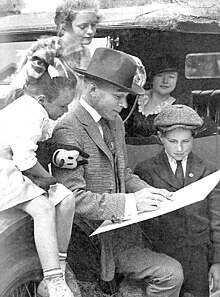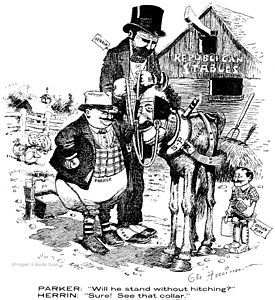| George Herriman | |
|---|---|
 George Herriman with some of his fans. | |
| Nationality | American |
| Area(s) | artist, writer |
Notable works | Krazy Kat |
George Joseph Herriman (August 22, 1880 – April 25, 1944) was an American cartoonist, best known for his comic strip Krazy Kat.
Biography
George Herriman was born in a light-skinned, Creole African-American family in New Orleans, Louisiana. Both of his parents were listed as "mulatto" in the 1880 census. In his adolescence, Herriman's father moved the family to Los Angeles, California, as did many educated New Orleans Creoles of Color at the time in order to avoid the increasing restrictions of Jim Crow laws in Louisiana. In later life, many of Herriman's newspaper colleagues were under the impression that Herriman's ancestry was Greek, and Herriman did nothing to dissuade them of this notion. According to close friends of Herriman, he wore a hat at all times in order to hide his "kinky" hair. He was listed on his death certificate as "Caucasian".
At the age of 17, Herriman began working as an illustrator and engraver for the Los Angeles Herald-Examiner, and over the next few years did many newspaper spot illustrations, observational and political cartoons, and produced several early comic strips, at times producing several daily strips at the same time. Herriman's early strips included Major Ozone, Musical Mose, Acrobatic Archie, Professor Otto and his Auto, Two Jolly Jackies and several others, most of which were only slightly above the average quality of newspaper strips of the time.
Perhaps the first indication of Herriman's unusual creativity and poetical sense of humor which would make him famous surfaced in 1909 with his strip Goosebury Sprig. The following year Herriman began a domestic comedy strip called The Dingbat Family. The precursors to the characters of Krazy and Ignatz first appeared in a small, unrelated side comic (begun on July 26, 1910) that ran below "The Dingbat Family". The small comic appeared intermittently before becoming a regular feature of the strip: the main action happening with the human family taking up most of each panel, and an unrelated storyline involving a cat and mouse underneath the family's floorboards taking place in the bottom segment of each panel. This strip was then renamed The Family Upstairs. The cat and mouse strip was then spun off into another strip in 1913 , originally Krazy Kat and Ignatz, and then simply Krazy Kat.

Herriman also continued drawing the domestic comedy strip, again named The Dingbat Family, until 1916 . From 1916 through 1919 Herriman also drew the daily strip Baron Bean. Herriman would continue to draw other strips in addition to Krazy Kat through 1932.
Krazy Kat, however, was the strip which became Herriman's most famous. It reached its greatest level of popularity in the early twenties, when it inspired merchandise, critical acclaim, and even an interpretive ballet. Over the years it gradually lost readers, and many complained that "it made no sense." However it had an enthusiastic (if relatively small) following among art-lovers, artists, and intellectuals of the era, such as the critic Gilbert Seldes and the poet E. E. Cummings. Most importantly, it was championed by Herriman's publisher, William Randolph Hearst.
Herriman was also the illustrator for the first printed edition of Don Marquis' archy and mehitabel stories.[1]
The 1930's were a period of tragedy for George. In 1934, his wife Mabel died in an automobile accident. In 1939, his daughter Bobbie died unexpectedly at age 30. He never remarried, choosing to live in Los Angeles with his cats and dogs.
Death
He died in his sleep on 26 April, 1944.[2] His cause of death was listed on his death certificate as "non-alcoholic cirrhosis of the liver". According to his request, his ashes were scattered by airplane over Monument Valley, Arizona.
On June 25, 1944, two months after Herriman's death, the last of his completed Krazy Kat strips, a full-page Sunday, was printed. An incompletely inked pencilling of six daily strips was found on his drawing board at the time of his death. At the time, Hearst usually brought in new cartoonists when the artists of a popular strip died or quit, but an exception was made for Herriman, as no one else could take his place.
Friends and biographers described him as a solitary man who gave generously to charity, loved his family and enjoyed a good game of poker.
Identity in Herriman's work
Herriman's work has been analyzed by numerous critics and theorists. Some see reflections of Herriman's complex experience of America's identity reflected in his work. His surreal and shifting settings are a background to changing ethnicity and gender of the central characters. Eyal Amiran points out in an essay in Mosaic that, in some later strips, Krazy and the other characters switch between black and white.[verification needed] The strip's love triangle has also been described as a "thwarted fantasy of miscegenation"[3] in which "the white (mouse) Ignatz loves to hate Krazy, but only as long as he/she is black. Black Krazy loves Ignatz only as long as he's white." Meanwhile, the white police dog, Offisa Bull Pupp, is secretly in love with Krazy, the black cat. Heer highlights one strip in which Krazy leaves a beauty salon covered in white makeup. Ignatz sees Krazy and is in love. In another strip, Ignatz is blackened after hiding in a pipe and Krazy's love for the mouse does not resume until his black face is washed clean.[3] However, this interpretation is perhaps somewhat invalidated by Herriman's insistence that Krazy was not female -- he saw Krazy as a "pixie", beyond gender or sexuality.[4]
In another strip published in 1931, an art critic visits and describes Krazy and Ignatz as "a study in black & white". Krazy responds saying "he means us: Me bleck, You white" and suggests that the two "fool him. You be bleck and I'll be white" and in the next panel Krazy is white while Ignatz is black. The critic responds by declaring the transformation "another study in black & white".
An earlier cartoon of Herriman's, Musical Mose (1902) features a black man who tries to impersonate a white man declaring, in dialect, "I wish mah color would fade", might be an example of Herriman mocking himself.[3]
Strip bibliography

| Year | Strip |
|---|---|
| 1902 | Musical Mose |
| Professor Otto and his Auto | |
| Acrobatic Archie | |
| 1903 | Two Jollie Jackies |
| Lariat Pete | |
| 1904 | Major Ozone's Fresh Air Crusade |
| Home Sweet Home | |
| Bubblespikers | |
| Bud Smith | |
| 1906 | Mr. Proones the Plunger |
| Rosy Posy, Mama's Girl | |
| Zoo Zoo | |
| Grandma's Girl | |
| 1909 | Baron Mooch |
| Mary's Home from College | |
| Gooseberry Sprig | |
| Alexander the Cat | |
| Daniel and Pansy | |
| 1910 | The Dingbat Family/The Family Upstairs |
| 1913 | Krazy Kat |
| 1916 | Baron Bean |
| 1919 | Now Listen Mabel |
| 1922 | Stumble Inn |
| 1926 | Us Husbands |
| Mistakes Will Happen | |
| 1928 | Embarrassing Moments |
| 1930 | archy and mehitabel |
References
- Patrick McDonell, Karen O'Connell, and Georgia Riley De Havenon, Krazy Kat: The Comic Art of George Herriman (New York:Abradale Press, 1986).
- Krazy & Ignatz in "A Wild Warmth of Chromatic Gravy": The Komplete Kat Komics 1935 - 1936 by George Herriman (Fantagraphics Books:2005) ISBN 1-56097-690-X )
- George Herriman dossier Krazy.com
- George Herriman dossier ReadYourselfRAW
Footnotes
- ^ Don Markstein's Toonopedia. "archy and mehitabel".
- ^ "Among the Unlimitless Etha". Time (magazine). May 8, 1944. Retrieved 2008-05-10.
George Herriman, 63, creator of the sovereign comic strip, Krazy Kat, died after a long illness.
((cite news)): Check date values in:|date=(help); Cite has empty unknown parameter:|coauthors=(help) - ^ a b c Heer, Jeet (2005-12-11). "A cat-and-mouse game of identity (Abstract)". thestar.com. Toronto Star. Retrieved 2007-06-20.
A cat-and-mouse game of identity: Excerpt: George Herriman played with race in his work and real life
((cite web)): Cite has empty unknown parameter:|accessyear=(help) - ^ Walker, Brian, The Comics Before 1945
External links
- George Herriman biography on Lambiek Comiclopedia
- George Herriman biography on Don Markstein's Toonopedia
- Major Ozone, Krazy Kat, Gooseberry Sprigg, The Family Upstairs articles on Don Markstein's Toonopedia
- Krazy Kat - The Coconino County Home Page
- George Herriman biography on Pioneering Cartoonists of Color
- Krazy Kat and Ignatz Mouse at the circus (26 MB), Krazy Kat goes a-wooing (20 MB), Krazy Kat, bugologist (30 MB) MPEG animation files
Template:Link FA